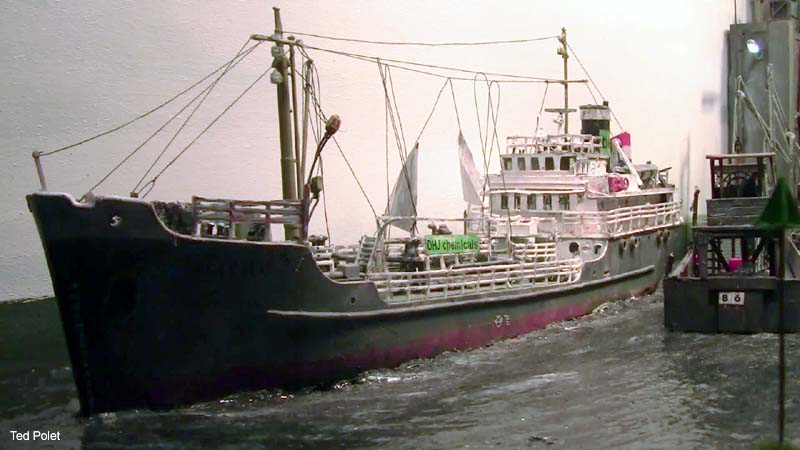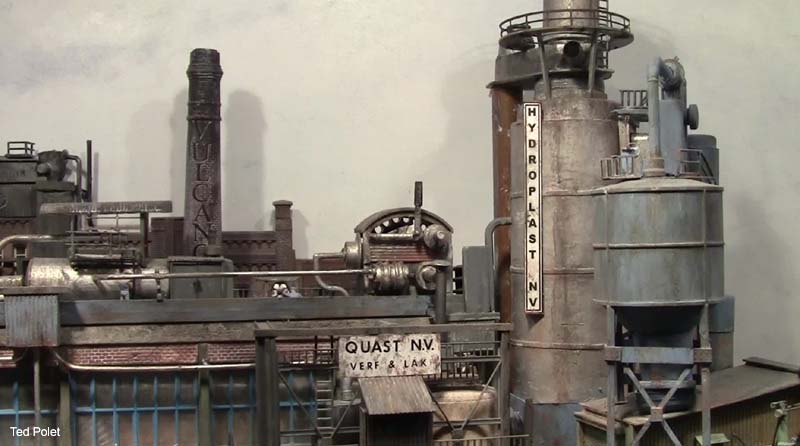
The name of Smeerdijk was chosen to express the polluted character of this layout. The village situated behind the industrial area carries the same name. Smeerdijk is a typical Dutch polder village, behind a tidal river dyke in the southwest of the country. There is a small quay outside the dyke, on tidal water which is typical for the area, and a canal quay on non-tidal water behind the dyke. As often is the case in this area, an industrial estate was developed from the start of the 20th Century, which over the years attracted various chemical industries. These are linked to the standard gauge railway network and to the Cape gauge RTM network. The idea was inspired by the area around the old village of Pernis to the south of Rotterdam.
The layout is to H0 scale and consists of three units 80x40cms and a 60cm fiddle yard with a sector plate. Total length is 3 metres, and the layout can be viewed from the front and from the left. The units are numbered 1 to 3, and Henk Wust has represented a time line in the layout starting with a 1920s chemical plant on the left, continuing to a 1960s plant on the extreme right.
We started building this in 2010, re-using existing Fremo standard baseboard units. The track plan was designed by Derk Huisman who wanted to be able to use it as a shunting layout. He also laid the track and fitted the wiring on all the units.
Unit 1 shows the tidal river with a chemicals tanker owned by DHJ Chemicals, a view of the river dyke and one of the typical 'cribs' or guide dams in the area keeping the current away from the quay. The tidal water reaches higher than the polder water table - the canals are behind a system of locks. The single narrow gauge track on the quay is based on the Rotterdamsche Tramweg Maatschappij (RTM). Next, we will describe some of the industries.
Smeerpijp & Sons is a producer of oil, grease and various lubricants for the heavy industry. This is set up as a 1920s chemical plant with brick buildings.
VULCANO, situated up against the backscene, is another 1920s industry producing rubber tyres, seals and glands.
The second unit is dominated by the big paint factory, with a small plant to the right of it which produces plastic products. In the foreground is the access gate to the industries on the centre and right units, numbers 2 and 3.
QUAST NV VERF & LAK is a paint producing plant for private and industrial customers. On the premises a fire exercise is being conducted by the DHJ Chemicals company's fire unit. This can be called up for fires or chemical incidents on the entire estate. The exercise is being held by two fore engines and a road tank which is used to pump away any chemical leakages.
HYDROPLAST NV produces plastic granulate for various other industries. Waste plastic from the Hydroplast plant is being used as a source material for one of the DHJ Chemicals plants on unit 3. The scene around the gate is very busy because of a shift change at DHJ Chemicals. The police have been called in to prevent anything untoward happening.
The entrance to the industrial site on unit 3 is just on unit 2, and closed off with a barrier. There is one-way traffic in force except for the canal quay. On the right a road tanker owned by the well known tanker firm of Frans Maas is trying to leave the premises through the narrow exit road.
DHJ CHEMICALS produces various chemicals for other industries. In the old factory hall in the back corner, plastic boxes and containers are made in various sizes, using plastic waste from the Hydroplast factory next door.
PHOSCHEM is - as you might guess - a phosphor processing plant based on a similar industry further south (Thermphos in Flushing). The raw material is brought by canal barges - there is a barge with a load of phosphor ore alongside the quay.










